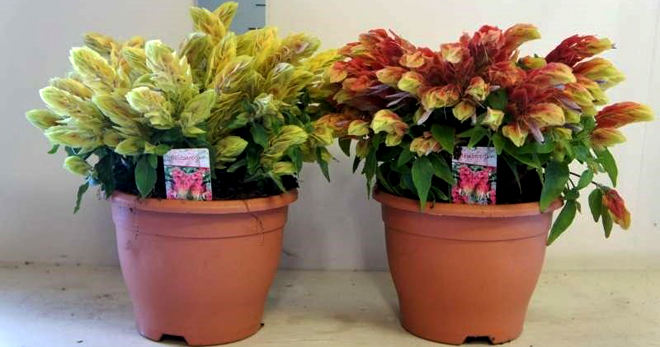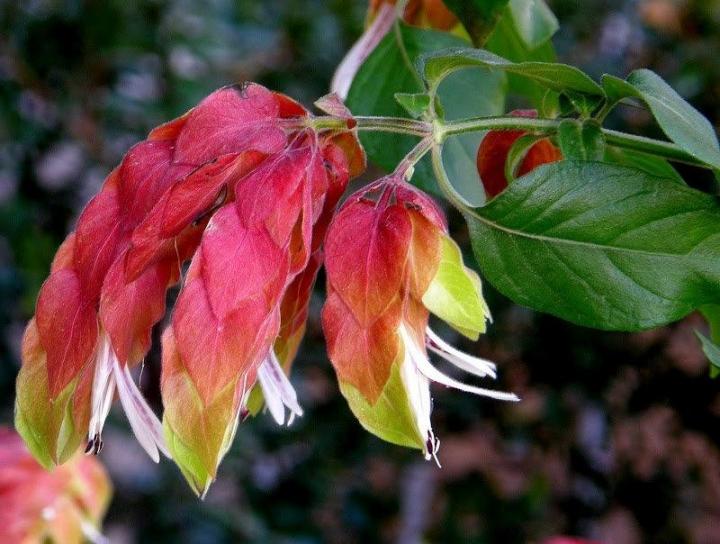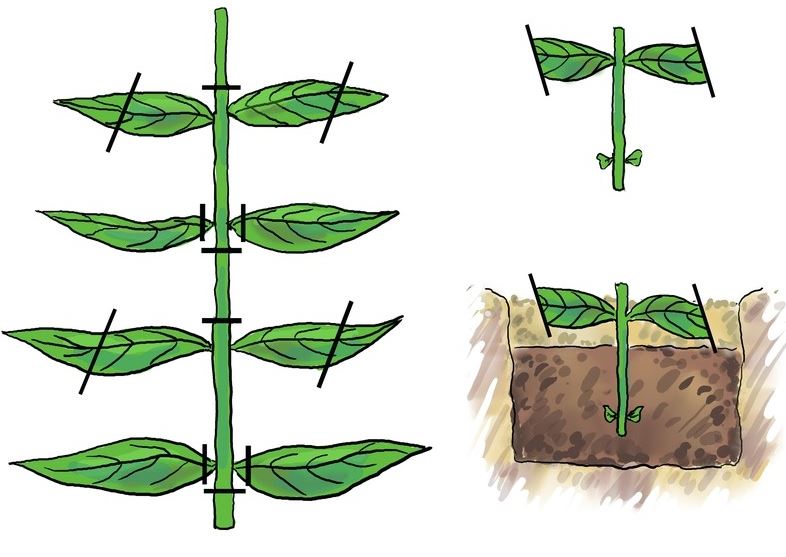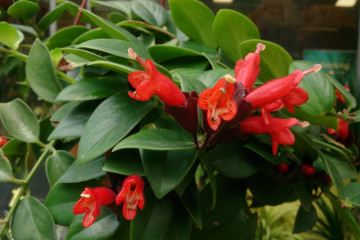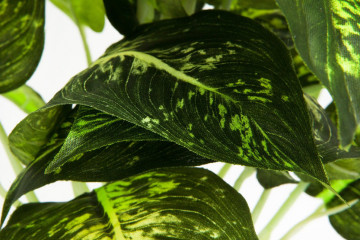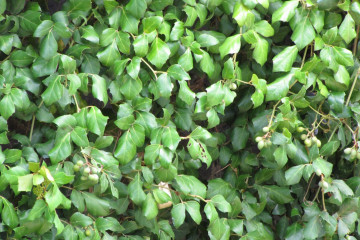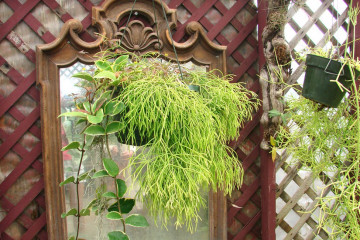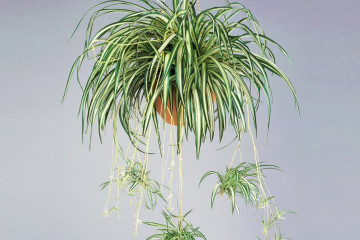Beloperone: home care and reproduction
Content:
Beloperone flower (translated from Latin as "arrowhead") belongs to the Acanthus family, has more than 50 types of culture. Blooming perennials grow in the tropical forests of South America, known for their warm and humid climates. The culture is unpretentious in care and is rarely attacked by insects.
Main varieties
Beloperone variegated
Beloperone variegated stands out against the background of analogs with white spots (in places where chlorophyll is absent), with an average height of 60 ... 70 cm and bright red or white inflorescences. Justice is unpretentious to air humidity and soil - it is enough to provide watering every 3 days, irrigate the leaves every other day. Cuttings take root quickly and grow well. Culture blooms all year round. Many growers propagate indoor hops commercially.
Beloperone drip
When grown in an apartment, beloperone care at home allows the plant to gain a height of 90-110 cm in several years. Adults are impressive with an abundance of spike-shaped flowers that stand out against the background of bright emerald foliage. The length of the inflorescences reaches 15-17 cm. However, the key feature in the care of drip beloperone is the high demand for lighting, it is important to provide full daylight hours (11 = 13 hours).
Beloperone Rouge
Beloperone Rouge bushes grow at home up to half a meter, the shoots are partially covered with tree bark, a genuine interest in bright, 10-20 cm flowers is aroused. According to the description, the tailed home strophanth blooms all year round, easily tolerates a wide range of temperatures. The leaf blades on the stems grow in pairs (opposite), oval, lanceolate, pubescent or slightly pubescent. The length of the leaves is 2-6 cm, short hairs are developed on one or both sides, giving a velvety appearance. Stipules are lemon-colored, the flowers are brown at the edges, creamy pink at the base, strewn with light specks.
Home care
Watering
When caring for beloperone in a warm period, abundant watering should be provided, the soil should have time to dry out. Excess liquid is removed. In winter, the crop is watered less frequently, as a light dry crust appears on the surface. Water at room temperature is used to moisten the soil.
Location
A tropical plant actively develops in intense diffused light. It feels most comfortable from the south or south-east side. The main thing is to exclude direct sunlight. Lack of light provokes faded bracts. In low light in winter, indoor hops are strongly stretched, loses attractiveness.
Temperature
Beloperone prefers a moderate temperature regime, a minimum of 15 ° C. If the room is heated in winter, the plant sheds its leaves. In summer, at temperatures above 21 ° C, the flower requires good ventilation without drafts; placement in the open air in partial shade is also suitable.
Pruning
Beloperone needs regular pruning. Each spring, the shoots are shortened by 1 / 3-1 / 2. The procedure improves branching. Cuttings after pinching are used for reproduction.
Soil and pot
The root system of the white perone indoor flower grows quickly, but the processes are fragile, the pot should be chosen with an increased diameter.The container is filled with soil, it is possible to use 2 options:
- A mixture of leafy, soddy soil and humus in a ratio of 2: 2: 1;
- Substrate of sand, peat and humus (1 part each).
Adding bone meal to the soil mixture is recommended.
Humidity
Beloperone comes from warm countries and needs a sufficient level of humidity. Irrigation of the culture is carried out with a spray bottle. The procedure is carried out no more than once a day, controlling the formation of fungus on the leaves and shoots.
Top dressing
From March to September, the culture is additionally fertilized, thanks to top dressing, the flower blooms profusely, takes on a beautiful and healthy look. In spring and summer, fertilizers are added twice a month, at temperatures below 18 degrees Celsius - monthly.
Any fertilizer for home flowers is suitable for Beloperone. Mineral fertilizers are required, allowing the soil to be moistened instead of ordinary water.
Plant transplant
Beloperone is transplanted as the flowerpot is filled with roots. Young individuals are seated annually, with intensive growth, the procedure is carried out twice a summer. During transplantation, you should carefully deal with the roots of the culture, the processes are very vulnerable.
Reproduction methods
For the owners of the beloperonia flower, care and reproduction in artificial conditions does not cause difficulties, the plant easily tolerates transplantation, soil change, "moving", grows quickly when cuttings or sowing seeds.
Cuttings
Cuttings are carried out with the onset of spring, the effectiveness of rooting in other periods will be much lower. The procedure is carried out in the following sequence:
- Young shoots 10-15 cm long are cut at an angle of 45 ° - the measure will allow you to get the maximum number of roots. The cut is treated with a hormonal solution for rooting.
- The stalk is planted in a small pot with a substrate and watered abundantly.
- The plant is covered with a transparent plastic bag, moved to a warm corner, protected from direct sunlight.
- After 6-8 weeks, the cuttings are ready for transplanting into a permanent flowerpot. The sprouted stalk is removed from the bag gradually, over several days. The bag is first opened for a few minutes, then the time that the appendix is in the fresh air is gradually increased until it is completely released.
- After planting in a permanent place, the cutting is fertilized: in the warm season, feeding is carried out 2 times / month, in the cold - 1 time.
Seeds
Seed propagation is carried out in February-March, but it is possible to obtain excellent seedlings in indoor conditions throughout the year. The process takes place in several stages:
- Seed material is prepared - orange cannons are carefully removed from the tip of individual seeds.
- The seeds are soaked in warm water for 48 hours.
- Create a sowing soil by mixing coarse sand with soil in a 2: 1 ratio. The pots are filled with the substrate.
- Seeds are evenly poured onto the surface of the ground and covered with a small layer of substrate.
- Vases are placed in a warm place.
The seeds will sprout after 4-8 months, the sprouts will be ready for transplantation into a permanent flowerpot.
Diseases of beloperone
Beloperone is resistant to negative factors, but there is a risk of damage by pests. More often, the culture is attacked by the following pests:
- Aphid. Leaves curl, change color, new shoots are twisted. In order to prevent the appearance of aphids, you should take care of the flower and periodically wipe it with a solution of pyrethrum or soapy water; in advanced cases, the culture will be saved by Fosbecid or Aktellik.
- Whitefly. It occurs on shoots and leaves in warm and humid conditions.Especially insects like poorly ventilated places where plants are planted too often. The insect is afraid of drugs: "Decisom", "Actellika".
- Spider mite. The presence of the parasite is indicated by the yellowness of the foliage, the characteristic silvery cobweb. If at the initial stage of the disease the culture is not treated with Actellik, the plant may wither.
- Shield. It manifests itself as gray-brown growths on leaves and shoots, gradually increasing in volume. The surrounding areas of tissue turn yellow or red, the ground in the flowerpot becomes unnaturally black. The situation requires processing the flower with available means: "Metaphos", "Fosbecid", "Fitoverm", "Aktellik". After 2-3 hours, the pests will die.
Beloperone is an unusual flower that is not very popular among gardeners. The culture has many advantages: long and abundant flowering, decorative foliage, ease of care. The plant draws attention to its rich color palette and sophisticated flowering.
Video
